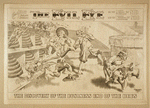"Woodcarver Bert Ohnstad carved canes, bowls, totem poles, and a number of sculptures, but his masterpiece was his Friendship Cane, to which he devoted more than fifty years in the making. The cedar limb used to make the cane was cut in 1928, as Ohnstad led a Boy Scout troop on a hike in Oklahoma. A fellow scout leader gave Ohnstad a memento to attach to it, a tiny gold heart with an inscription of the Lord's Prayer. From then on, people gave him tiny charms and keepsakes to attach to what he had begun to call his Friendship Cane. Ohnstad carved little niches into the cane and embedded such wonders as a tiny 64-square checkerboard, a shark's tooth, and a petite compass taken from a deceased German soldier's wrist during World War I. Close inspection reveals six miniature peek-holes embedded into the body of the cane, which reveal glimpses of Niagara Falls ,the Golden Gate Bridge, the White House, a Greek nymph, the Washington Monument, and the Lord's Prayer. Other attachments include a diamond-studded Rotary pin, a gold coin, a locket, a tiny "arrow head," a Scottie dog charm, a charm commemorating the Piccard statosphere flight, an eagle mascot pin from the 15th Wisconsin Regiment of the Civil War, and a Norse Immigration Centennial Medallion. Ohnstad counted more than one hundred objects and images carved into, attached to, or embedded into the cane, which exists as a travel diary, masculine version of a charm bracelet, and a remarkable piece of art and Americana."
--Leslie Umberger, Messages & Magic: 100 Years of Collage and Assemblage in American Art
Leslie Umberger's account of Bert Ohnstad's Friendship Cane, a part of the John Michael Kohler Arts Center Collection, gives us a glimpse of an art form that clearly draws upon the much older tradition of the reliquary as well as the Victorian interest in keepsakes, secular relics, and tokens of friendship and memory. Ohnstad's cane, produced between 1928 and 1979, is the material record of those with whom his life intersected through friendship. His efforts to embed keepsakes within the cane and to create nostalgic "peep holes" suggests privacy, insight, and interiority--a glimpse of the artist and of the era. Yet in transforming the typically utilitarian cane into a numinous object, Ohnstad's artwork also prompts us to reflect more deeply about our own private history.
Monday, February 15, 2010
Masculine Charms
Labels:
Americana,
art,
crafts/fanciwork,
friendship,
heirlooms,
keepsakes/talismans,
material things,
memory,
relics
Subscribe to:
Post Comments (Atom)






No comments:
Post a Comment